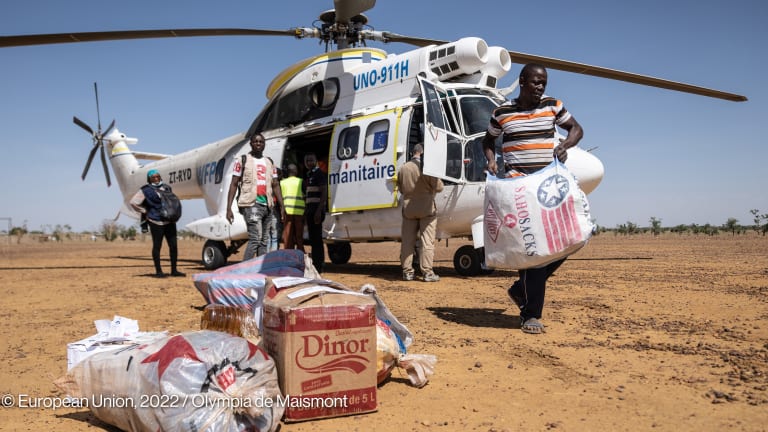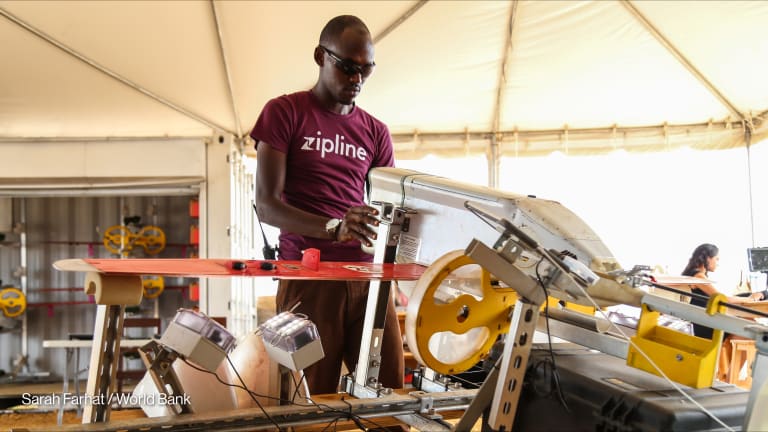
For the World Food Programme, scaling up operations in Europe to respond to the Ukraine crisis is something of a Catch-22: Unlike in many conflict areas, the necessary infrastructure — adequate roads, trucks, warehouses — to transport large amounts of food and other humanitarian supplies already exists, but so do layers of national and regional regulations that require the agency to comply with customs and border laws.
This has complicated the response from the organization, which acts as the main logistics hub for the humanitarian system, as it works to mobilize its capacity to respond to an entirely new type of conflict.
Get the inside track on how agriculture, nutrition, sustainability, and more are intersecting to remake the global food system in this weekly newsletter.
“It’s only been about a month, [and] the level of scale-up that we’ve managed to do in such a short amount of time could not have been done in similar areas where you’d actually have to build and put infrastructure down. There’s hotels. You can rent offices,” Alex Marianelli, supply chain director at WFP, told Devex from Rome.
“We’re not used to operating in such environments. It’s very luxurious for us to have all the trucks and all the warehouses. … The other edge of that coin is customs clearances: clearing armored vehicles, body armor, food — all of those things one needs to implement a humanitarian operation in a conflict. These are very well articulated rules,” he continued. “They can’t break their laws.”
This is just one of many challenges that WFP faces while operating in Ukraine and its neighboring countries.
The organization previously had no presence in the area, so it had to divert staffers and resources from other crises to respond. Commodities are getting held up in customs. A backlog of ships in the Black Sea — no longer able to make deliveries to Russia, under international sanctions — are offloading goods into warehouse space that WFP needs for humanitarian supplies. And ongoing violence within Ukraine makes it impossible to reach the hardest-hit areas with aid convoys, Marianelli said.
Before the conflict began, WFP sent a team to Kyiv to evaluate existing supply chains and markets, analyzing what might happen if a conflict were to break out.
“One of the biggest challenges is, you [are] starting from zero. … [That] really makes this first three weeks way more intense, because you don’t have the partnerships, the contracts, all of that local knowledge which you need in order to operate,” Marianelli said. WFP recognized that it had a knowledge vacuum, he said, with Ukrainian and Polish staffers elsewhere around the globe being sent in as part of the first wave of responders to the crisis.
As the conflict escalated, this team was pulled out of Kyiv, but WFP continued to call on staffers with regional knowledge and local language skills to aid in the response. More are joining the effort to set up operations in Poland, Romania, Hungary, Slovakia, Moldova, and Ukraine itself.
WFP has prioritized shipments of ready-to-eat food because they can be given immediately to people in transit. Marianelli analyzed his supply chain to determine what was the most efficient way to get those goods to Ukraine, given how rapidly the situation was evolving, and where he might have flexibility. He chose to divert rations in Turkey because there was already sufficient stock in Syria, their intended destination, to last several weeks. Supplies are then replaced once WPF receives donor money for Ukraine.
“We’ve got a pretty well-developed system of loan and borrowing. We can divert vessels. We do that all over the world,” Marianelli said. “We have a very, very agile supply chain because it is what we do.”
WFP’s operations in the region are funded through the end of April, Marianelli said, and he has ordered 50,000 tons of food that are at various points in the supply chain. WFP’s existing relationships with logistics companies are allowing it to move goods quickly, but there is still a delay. After an order is placed, about a month passes before it arrives, he said.
“The idea is to have a reactive capacity … to react within, ideally, an under-12-hour response time.”
— Alex Marianelli, supply chain director, WFPAs long as it remains possible amid supply chain disruptions, WFP will source food locally to support markets inside Ukraine instead of transporting thousands of metric tons of purchases across Europe, Marianelli said.
“It’s not possible to [source everything from local markets] at 100% because of those disruptions, so we are still indeed buying food and bringing it in,” he said.
Marianelli said the supply chain has been a lot more resilient than WFP initially predicted. Although the organization can’t get into besieged cities with convoys, it is working with local bakeries by purchasing any bread that they can produce. WFP then connects bakeries with local organizations, such as chapters of the International Federation of Red Cross and Red Crescent Societies, to distribute the bread to people in need.
Because WFP traditionally imports so much wheat from Ukraine, it had existing relationships with suppliers who were able to put the organization in touch with mills, which in turn could recommend bakeries to work with. WFP now has a list of participating bakeries and is also looking to set up local trucking capacity to help facilities that can operate but don’t have a way to transport bread.
While that solution is working for now, fuel will eventually run out.
“I’m really concerned about fuel — fuel supply for the millers, for the bakeries to work, for the harvest, which is coming in July, and for the summer planting season,” Marianelli said.
Access — not the availability of commodities and transport vehicles — remains the largest challenge, Marianelli said. WFP isn’t currently sending any vehicles to conflict zones. But WFP is already preparing in case access changes, assembling a fleet of vehicles that are appropriately marked and identifiable as humanitarian convoys.
The organization is also ensuring supplies are pre-positioned so it can move as soon as this is safe to do.
“The idea is to have a reactive capacity, an opportunistic capacity," Marianelli said, so that “we have the capacity to react within, ideally, an under-12-hour response time” after a cease-fire declaration or another event that allows for access. “We’ve got convoys ready today.”









